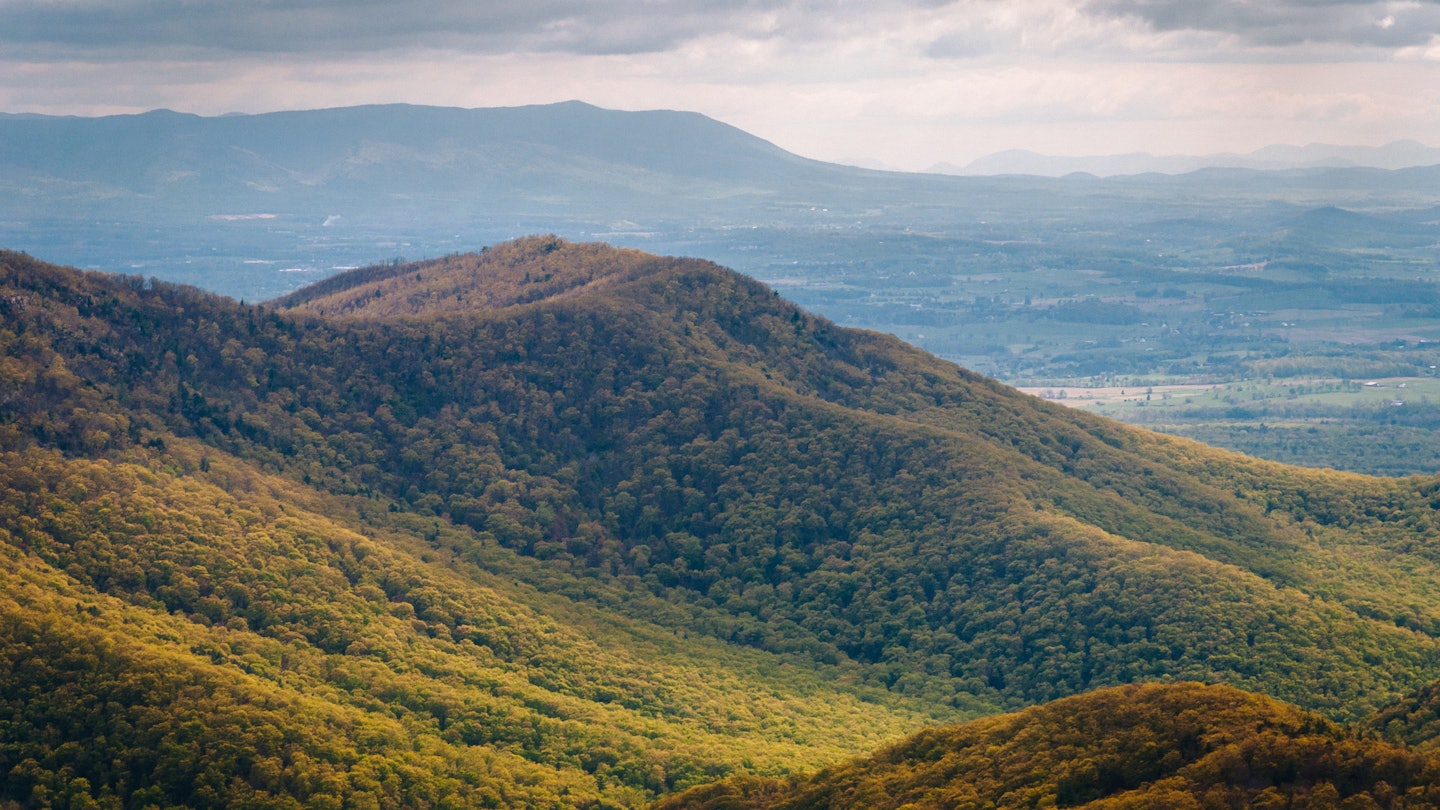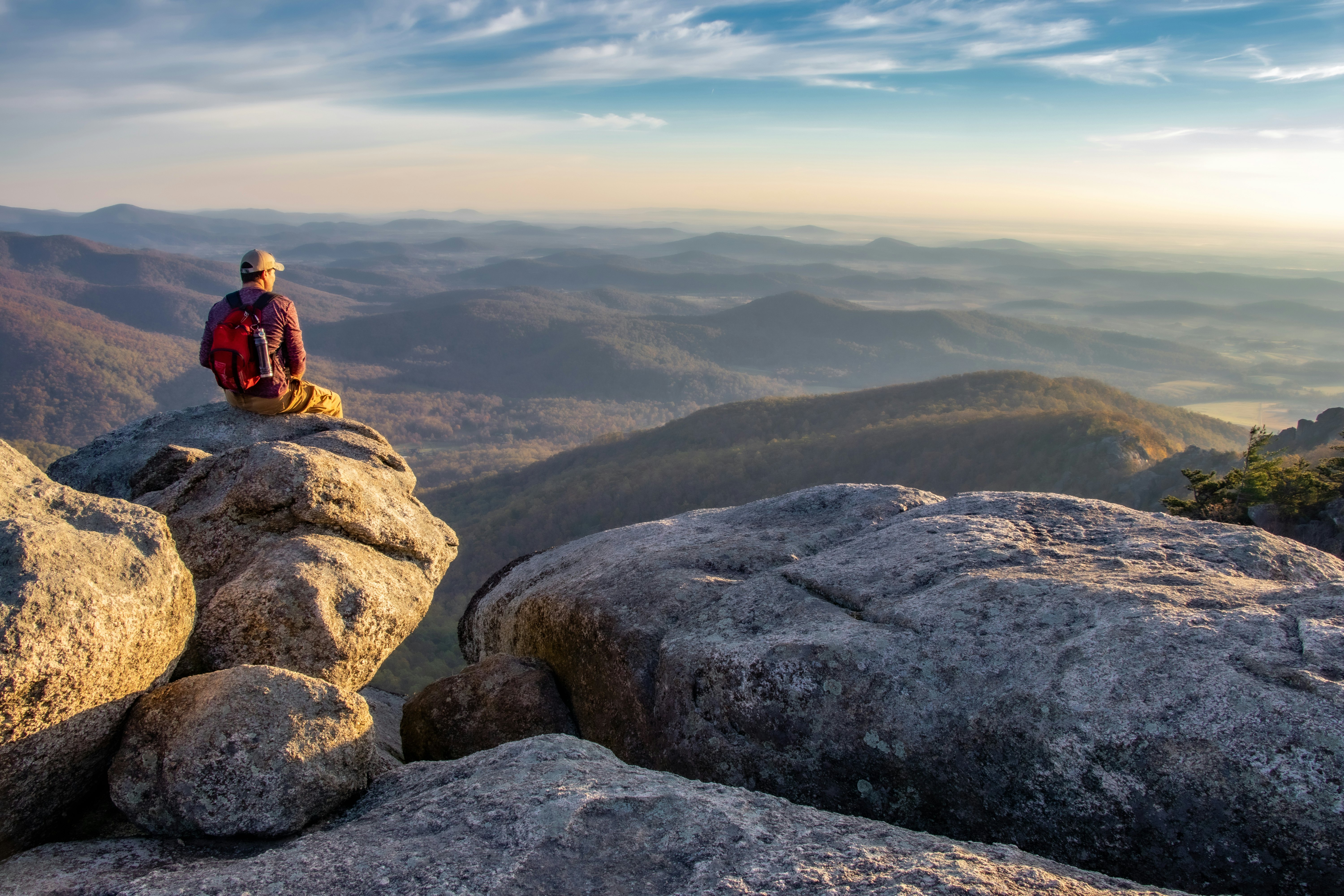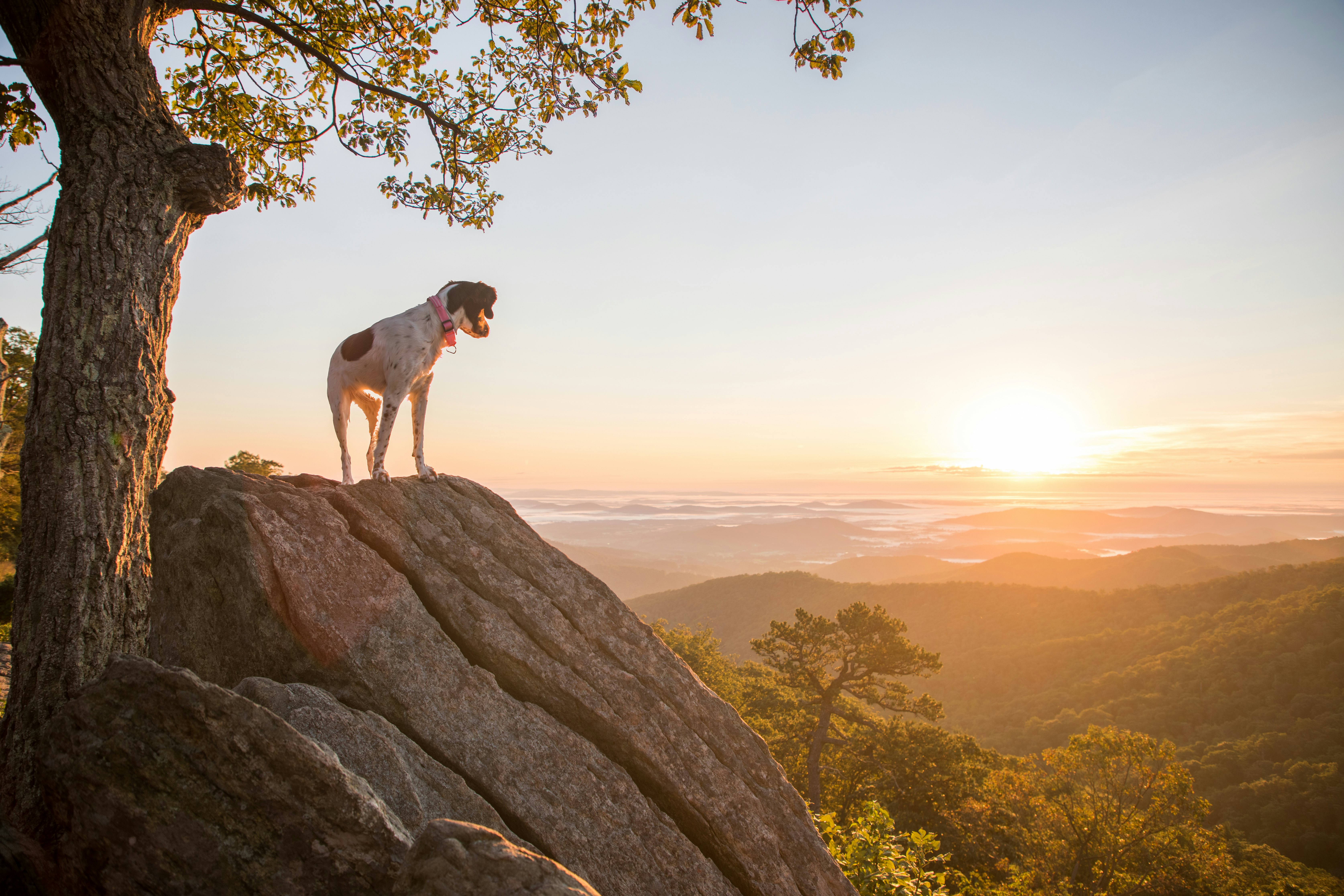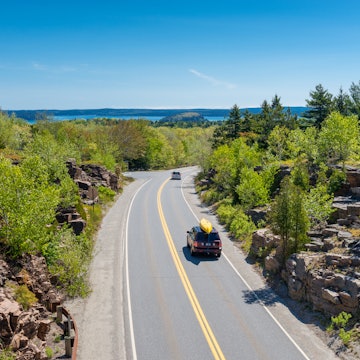

Plan your time and budget with this guide to Shenandoah National Park. Jon Bilous/Shutterstock
Shenandoah National Park isn’t exactly bite-sized, but it is well-suited for a one- or two-day visit. This skinny park stretches 105 miles along the crest of the Blue Ridge Mountains, where viewpoints overlook the gentle Virginia Piedmont to the east and the farm-dotted Shenandoah Valley to the west. Skyline Drive bisects the park and connects all 70 viewpoints.
Home to more than 500 miles of trails and easily reached from Washington, DC, the park is an excellent day-trip destination. Trails climb to overlooks built by the Civilian Conservation Corps and drop to mossy waterfalls that shimmer after rainstorms. The hike to the rocky summit of Old Rag is one of the most challenging day hikes in Virginia. It’s also a ton of fun. Skyline Drive is refreshingly free of billboards and stoplights, and it’s a fine choice for a leaf-chasing road trip in the fall.
But it’s the small moments in Shenandoah that you might remember most, whether admiring pink azaleas in bloom along the trail or gazing at a broad-winged hawk as it coasts on thermal winds during its annual fall migration.
Note: Due to staffing cuts, the National Park Service is stretched this year. Travelers can expect longer wait times, fewer services and potential closures of certain areas. Stay prepared with this guide.

When should I go to Shenandoah National Park?
The park hosts its annual Wildflower Weekend in early May. Later in the month, the park’s azaleas are in bloom, and lush green foliage has returned to the trees. June through August is high season, when families travel to the park during the summer break. Expect crowds at campgrounds, lodges and on popular trails. Check weather reports if you plan to hike Old Rag in the high season. Much of the upper route is exposed, leaving hikers vulnerable to heat and the occasional afternoon storm.
Crowds converge on Skyline Drive during the fall foliage season, with leaves typically hitting peak color from mid- to late October. Fall is also a good time to watch raptors that fly south during their annual migration. They tend to follow the Blue Ridge Mountains during their journey. Skyline Drive remains open year-round, but many park facilities are closed November through February. Before visiting, check the park website for alerts about weather-related road closures in winter.
How much time should I spend in Shenandoah National Park?
If you’re pressed for time, don’t sweat it. The park works well for short visits. Start with a dose of park history at the Byrd Visitor Center at Big Meadows, where exhibits tell the story of the park's creation. Next, hike to the summit of Hawksbill and its 360-degree views – look northeast to see the boulders clustered atop Old Rag. Hawksbill is also a pretty spot for a picnic. In the afternoon, tackle one of the shorter waterfall trails. Eat dinner at Skyland Resort and admire the technicolor sunset. If you spend the night in the park, check the calendar and see if there's a night sky event happening.
The second day, pack a picnic and hike to the historic Rapidan Camp. Conclude your visit with a horseback ride at Skyland Stables or a scramble around the boulders at Bearfence, where even more panoramic views await.

Is it easy to get around Shenandoah National Park?
The park and Skyline Drive are best explored by car, although cyclists are a common sight on the byway. Mile markers dot the roadside along Skyline Drive. The park’s only gas station is in Big Meadows, which is located at Mile 51. There are no park shuttles. The Appalachian Trail (AT) runs parallel to Skyline Drive for much of its 101-mile journey through the park.
The northern entrance to Shenandoah is located in the town of Front Royal, which is 60 miles west of Dulles International Airport and 75 miles west of Washington, DC. From the Front Royal entrance, Skyline Drive ribbons south through the park’s North, Central and South Districts. The Dickey Ridge Visitor is in the North District, and Byrd Visitor Center is in the Central District at Big Meadows – where there is, in fact, an enormous tree-ringed meadow.
Skyline Drive passes park entrances at Thornton Gap and Swift Run Gap before reaching the park’s southern terminus at Rockfish Gap. Bordering I-64, Rockfish Gap is 95 miles west of Richmond. You’ll find most park amenities clustered near Skyland Resort or Big Meadows Lodge in the busy Central District.
Top things to do in Shenandoah National Park
Hit the Appalachian Trail
Stepping onto the legendary Appalachian Trail (AT) is easy. The white-blazed footpath runs the length of the park, and it pauses near spur trails that lead to some of Shenandoah's most iconic sights. From the Hawksbill Gap parking lot (Mile 45.6), take the short path to the AT. Turn left onto the AT and follow it south along a ridgeline that overlooks the bucolic Shenandoah Valley. In early summer, you might pass AT thru-hikers trudging north with their backpacks. From the AT, hook onto the Salamander and Lower Hawksbill Trails to complete a 2.8-mile loop to the Hawksbill summit, the park’s highest point at 4951ft.

Admire the beauty of Shenandoah's waterfalls
Waterfalls are a specialty of Shenandoah, and it’s ridiculously easy to find them between Big Meadows and Skyland in the Central District. It’s also easy to hike to two or three falls in one day, thanks to the many intersecting trails. Dark Hollow Falls gets crowded, but it’s a beauty as it drops 70ft through the thick forest greenery. Wildflowers dot the path to Rose River Falls, which is especially pretty after a rainstorm.
Learn local history at Rapidan Camp
When you first hear about Rapidan Camp, it can sound rather boring. A bunch of old cabins favored by Herbert Hoover? Who cares? Well, prepare to be surprised. A leafy 2-mile hike ends at a tidy collection of creek-side cabins frequented by Hoover and the First Lady during his presidency. Historic markers share stories of camp visitors and global events at the time. It’s an idyllic location, and the history is fascinating. Shuttle tours of the camp depart from Byrd Visitor Center. Tours usually take place during the high season, so be sure to check for availability.

Hike to the summit of Old Rag
The 9.4-mile loop hike to the summit of Old Rag in the eastern fringes of the park is a ton of fun if you're reasonably fit and up for an adventure. The fun comes during the one-mile push to the 3291ft summit of the Old Rag monadnock, where the trail climbs through a lengthy field of exposed granite boulders. Be prepared to jump, scramble, climb and squeeze as you navigate the giant rocks. Families with younger kids may prefer the smaller rock scramble at Bearfence (Mile 56) on Skyline Drive.
My favorite thing to do in Shenandoah National Park
Many of my oldest friends are hikers, and for the last 15 years or so, I’ve made time to meet them for a day hike in the park. I’ve meandered over snow patches on the Riprap Trail and huffed and puffed up Old Rag under the hot June sun. I also met a friend and her energetic dog Luke for a climb to the summit of Hawksbill.
Shenandoah is an easy meet-up spot because it’s centrally located in the Mid-Atlantic. Friends from Washington, DC, Northern Virginia and Richmond can drive there in less than two hours. Whether climbing to a summit, descending to a waterfall or moseying along the AT, there are trails for all skill levels. Numerous hikes can be completed in a half day, which allows time for picnics and an easy pace.
How much money do I need for Shenandoah National Park?
Shenandoah National Park is a great option for travelers on a budget. The entrance fee is $30 per car. Motorcyclists pay $25, and pedestrians and cyclists pay $15. The park typically has Free Entrance days every year, and they often coincide with a federal holiday.
Camping at one of the park’s four developed campgrounds is a low-cost option for an overnight stay. All campground sites are $30 per night. Backcountry camping requires a permit ($6) and a recreation fee ($9) in addition to the park admission. Hiker cabins at Lewis Mountain cost $50 per night; just be aware they don’t have bathrooms or running water. Cabins at Lewis Mountain with standard amenities begin at $176 per night. Rooms and cabins at Big Meadows Lodge begin at $124 per night and at Skyland Resort at $134 per night.
Both lodges have restaurants (lunch $15–20, dinner $19–32) as well as separate taprooms that serve pub fare. Waysides along Skyline Drive serve burgers, sandwiches and grab-and-go items ($8–13). Several camp stores in the park sell basic groceries. You can also stock up at grocery stores in Front Royal, Harrisonburg and Charlottesville.
How do I prepare for an Old Rag summit hike?
Old Rag is a standalone peak set apart from Skyline Drive. The primary trailhead for the climb to the summit is a one-hour drive from Big Meadows. Many visitors stay in Charlottesville the night before the hike. To manage crowds, the park now requires a day-use ticket (March to November; $2 per person), which you can purchase online. Cell phone service is spotty near the trailhead, so buy your ticket ahead of time. Start hiking by 7am on weekends to avoid backups on the trail.

Can I bring my dog?
Leashed dogs are allowed on most trails in Shenandoah as well as in all campgrounds. Dogs are not permitted on the Old Rag, Bearfence, Limberlost and Dark Hollow Falls trails, and a few others. Check the park website for full details.
Where can I see the best fall foliage?
Leaf peeping is a scenic highlight in the fall, but keep in mind that the leaves don’t all change color simultaneously. Rainfall, elevation and other factors play a role in the timing, which means you won’t necessarily see canopies of color blanketing the park for miles on end. But discrete swaths can be quite impressive. Check the park’s social media feed for updates on the best displays.
















